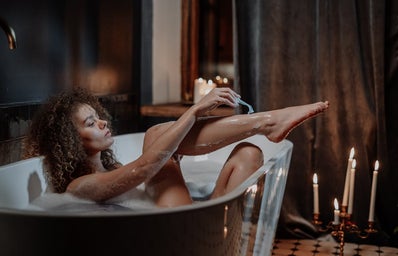This summer we were all going through it, to say the least. While this time will inevitably go down as one of the most challenging in the world’s history, I found it very beneficial to spend quarantine reevaluating my life and deciding what was actually important. During this self-reflective time accompanied by a few therapy sessions, I found that I care way too much about how my physical appearance is perceived within society. One of the things I obsessed over was making sure I always shaved my legs and underarms. All it took was one uncomfortable moment in eighth-grade gym class where I had forgotten to shave and felt as though the prying eyes of others were most definitely on me.
But with age and time I have come to the realization that no one in that gym class cared if I had stubble on my legs, and every other girl was probably just as insecure with themselves as I was. This made me wonder, why do I shave? Why do I spend 15 minutes every other day actively removing a part of myself that serves an evolutionary purpose? And furthermore, why do I associate body hair with shame and being unhygienic? It was from this point of realization in early June that I decided not to shave until school started. The decision made me want to delve deeper into why we as women feel the need to shave in the first place. Every woman can remember the first time she picked up a razor, or when their friends with older sisters show up to school with no leg hair and stories to tell. Why is it so ingrained in our psyche to care about stuff like that? With these questions in mind, I invite you on a journey through time and history to explore why we spend 59 days of our average lifespan as women shaving.
The First Razor
Invented around 3000 BCE and used by the women of Egypt and India, the first razor was made of copper. The women of ancient Rome would more commonly use methods such as tweezers, pumice stones, and depilatories. Hair removals tactics such as sugar waxing and facial hair removal (eyebrows, peach fuzz, etc.) were popularized in early history by ancient Egyptians all the way to women of the Elizabethan era. Furthermore, in the Renaissance of the 1400s female hairlessness was an indicator of class and goddesses in artwork from this era are seen sans pubic hair. There were, however, more real-life stakes to the removal of pubic hair in this time as lice was very common.
Fashion, pop culture and the age of common hair removal
With the popularization of sleeveless dresses in the early 1900s came a societal expectation that women have hairless underarms. Sleeveless garments accompanied by shorter hemlines of the Roaring Twenties led to the marketing of Gillette’s first female razor, the Milady Décolleté. Ads for the Milady Décolleté first aired in magazines like Harper’s Bazaar and commonly described hairy legs and underarms as “unsightly and objectionable” to the masses of female readers. The invention of the bikini and increase in Playboy magazine’s popularity also contributed to hairless women being viewed as more societally attractive.
The Age of Free Love
The Free Love movement which originated in the mid 1900s gained traction again in the 60s and 70s because of the Vietnam war. The sexual revolution and rejection of capitalism by young adults during this time, combined with women’s liberation and the push for decriminalization of homosexuality, led to women involved with this movement actively sporting body hair in opposition to the patriarchy and heteronormative beauty standards. Playboy also included a model with fully grown pubic hair in their magazine for the first time.
The Brazilian Wax Reaches the U.S.
With the beginning of the 90s came the pop culture boom of the Brazilian wax. Seven sisters from Brazil opened a waxing salon in New York and a cultural phenomenon was born. This new type of hair removal ushered in another age of common female removal of body hair. Some women, however, like Julia Roberts sporting thick underarm hair at the premiere of her movie “Notting Hill,” continued to challenge the societal expectation that women must remove their body hair.
Body Hair Removal Today
In 2016, a study showed 77 percent of 16-24-year-old women shaved their underarms and 85 percent of them shaved their legs. This was an 18 percent decrease in underarm shaving within this age group compared to 2013 when 95 percent of women shaved their underarms and a 7 percent decrease in leg shaving since 2013. I attribute this shift to celebrities like Miley Cyrus, who commonly dyes and uses her underarm hair to accessorize, and Gigi Hadid, who showcased her unshaven underarms in LOVE Magazine’s annual advent calendar. I have found it is far more common nowadays to see women from the red carpet to Instagram who are unshaven and proud of it.
The main theme that I have noted throughout history, is that body hair removal has often been gendered, a way to “prove” our gender role as women, rather than an exercise of free will as it should be. If you want to shave your legs because you just washed your sheets, then more power to you. If you want to shave because it makes you feel more confident, again, more power to you.
I do, however, encourage you to evaluate the why behind your shaving routine. As I shaved off my three months of hair growth at the end of the summer, I was left feeling empowered in my own body. I felt as though I was making a choice for me, as opposed to simply doing what I had always thought I was supposed to. I also discovered through this experiment that I was using the wrong type of razor for my sensitive skin, and that I was shaving far too often which made my skin drier and less moisturized.
To wrap up our little history lesson, shave if you want to or don’t! Body hair isn’t shameful and it isn’t a statement on your femininity, anyone who views it that way, romantically or socially, isn’t worth your time. Do it for you and not the patriarchy, collegiettes!



